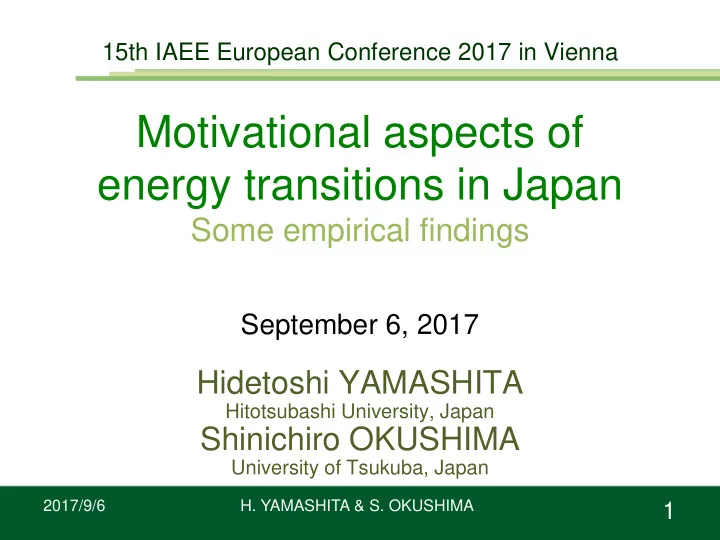

15th IAEE European Conference 2017 in Vienna Motivational aspects of energy transitions in Japan Some empirical findings September 6, 2017 Hidetoshi YAMASHITA Hitotsubashi University, Japan Shinichiro OKUSHIMA University of Tsukuba, Japan 2017/9/6 H. YAMASHITA & S. OKUSHIMA 1
Municipalities’ role in energy transitions Based on the informative examples like in Germany (e.g., Engelken et al., 2016), Austria (e.g., Schmidt et al., 2012) or Switzerland (e.g., Müller et al., 2011), It is well known that municipalities play a significant role in energy transitions. These studies show that motivation and performance of municipal governments are quite essential to realize locally-initiated energy transitions, and that there are large varieties of objectives and benefits municipalities pursue. 2017/9/6 H. YAMASHITA & S. OKUSHIMA 2
Municipalities’ role in energy transitions Motivational aspect Literatures based on European experiences show that economic benefits are not sole reason for communities to invest in renewable energy. Arentsen and Bellekom (2014) The majority of the motivations of communities can be categorized into four types: environmental, economic, dissatisfaction with government effectiveness, and social. Nonetheless, little empirical literature on this topic exists in Japan, as well as even in European countries (Engelken et al., 2016; Müller et al., 2011). 2017/9/6 H. YAMASHITA & S. OKUSHIMA 3
Purpose and Methods Background Conducted a questionnaire survey in 2014 Target : All of the 1,741 Japanese municipalities Response rate : 78.8% (1,372 municipalities) Purpose of this study is to specify the characteristics of municipalities which encourage renewable energies By means of Correspondence analysis 2017/9/6 H. YAMASHITA & S. OKUSHIMA 4
Encouragement of the use of RE We encourage their use under written guidelines such as ordinances, plans, targets, 41 71 or new energy visions. No written guidelines, but we implement policies to encourage use. 194 No written guidelines and no policy, but we show a stance of encouraging use through local government head statements and declarations of position. 80 Currently not encouraging use, but might 744 consider doing so in the future. Currently not encouraging use, no possibility of considering it in the future. 242 No response. Renewables encouraging municipalities: REMs 2017/9/6 H. YAMASHITA & S. OKUSHIMA 5
Reasons for encouraging the use of RE 0 100 200 300 400 500 600 700 358 invigorate R will invigorate the local community. 323 resource-use R will make effective use of idle land and local resources. 137 employment R will increase local employment. 37 R will halt local population decrease. population 106 R offer promise of revenues from property taxes, and other sources. revenue R help improve people’s impression of our locality. 218 impression 73 R offer promise of increased inspection tours and tourism. tourism 48 R will accumulate expertise and experience for business development. expertise 43 R will attract and foster renewable energy equipment makers. maker 452 R will bring about local consumption of locally produced energy . local-s 78 R offer promise of earnings from Feed-in tariffs. 283 R make possible a more robust response to disasters and other risks. disaster 117 Local government heads show positive leadership. 89 Local citizens and businesses are positive about R. 49 Outside businesses actively encourage commercial projects. 22 Nearby municipalities are actively pursuing R. 83 The prefecture is actively pursuing R. climate 607 R help reduce greenhouse gas emissions. national-s 169 R help raise the nation’s energy self -sufficiency rate. de-nuclear 55 R help phase out nuclear power. N=744, multiple responses 18 Other. 2017/9/6 H. YAMASHITA & S. OKUSHIMA 6
Categories: reasons Respondents: municipalities 2017/9/6 H. YAMASHITA & S. OKUSHIMA 7
Correspondence analysis Correspondence analysis is a sort of multivariate analysis. Mathematically, it calculates coordinates of categories and respondents in order to minimize the sum of the length of the segments which connect categories and respondents. Correspondence analysis plots two categories which are selected simultaneously by many respondents close to each other. Categories with few responses appear in the periphery of the scatter plots, while categories with many responses tend to be located around the origin. see Hayashi (1952) for detail 2017/9/6 H. YAMASHITA & S. OKUSHIMA 8
Categories: reasons Respondents: municipalities 2017/9/6 H. YAMASHITA & S. OKUSHIMA 9
2017/9/6 H. YAMASHITA & S. OKUSHIMA 10
2017/9/6 H. YAMASHITA & S. OKUSHIMA 11
2017/9/6 H. YAMASHITA & S. OKUSHIMA 12
2017/9/6 H. YAMASHITA & S. OKUSHIMA 13
2017/9/6 H. YAMASHITA & S. OKUSHIMA 14
2017/9/6 H. YAMASHITA & S. OKUSHIMA 15
2017/9/6 H. YAMASHITA & S. OKUSHIMA 16
2017/9/6 H. YAMASHITA & S. OKUSHIMA 17
Concusions Motivations of REMs can be categorized into three types by correspondence analysis: environmental, socio-economic, and concern on national energy policy. social and economic motivation may be weakly separable. Results agree with the insights from other countries. REMs with socio-economic motivation are to be core exponents of “locally initiated energy transition”. In order to increase them, we need to make REMs with other motivation turn to have this motivation, non-REMs with renewables potentials turn to be REMs. 2017/9/6 H. YAMASHITA & S. OKUSHIMA 18
References Arentsen, M., Bellekom , S. (2014), “Power to the people: local energy initiatives as seedbeds of innovation?”, Energy, Sustainability and Society , 4:2. Engelken, M., Römer, B., Drescher, M., Welpe , I. (2016), “Transforming the energy system: Why municipalities strive for energy self- sufficiency,” Energy Policy , 98, pp. 365-377. Hayashi, C. (1952), “On the prediction of phenomena from qualitative data and the quantification of qualitative data from the mathematico-statistical point of view”, Annals of the Institute of Statistical Mathematics , 3, pp. 69-98. Müller, M.O., Stämpfli, A., Dold , U., Hammer, T. (2011), “Energy autarky: A conceptual framework for sustainable regional development,” Energy Policy , 39, pp. 5800-5810. Schmidt, J. Schönhart, M., Biberacher, M., Guggenberger, T., Hausl, S., Kalt, G., Leduc, S., Schardinger, I., Schmid , E. (2012), “Regional energy autarky: Potentials, costs and consequences for an Austrian region,” Energy Policy , 47, pp. 211-221. 2017/9/6 H. YAMASHITA & S. OKUSHIMA 19
Recommend
More recommend